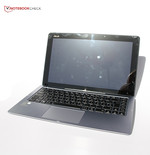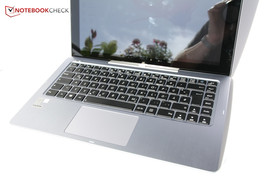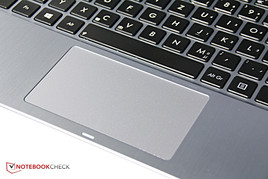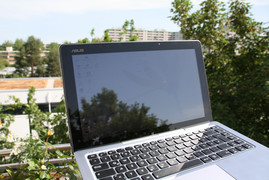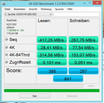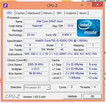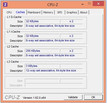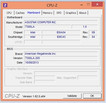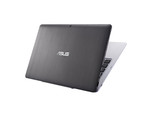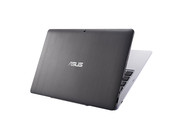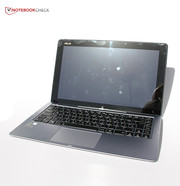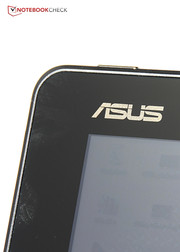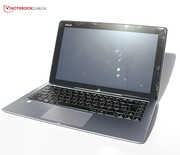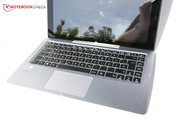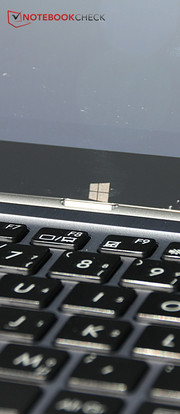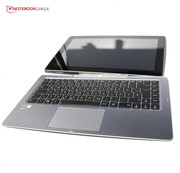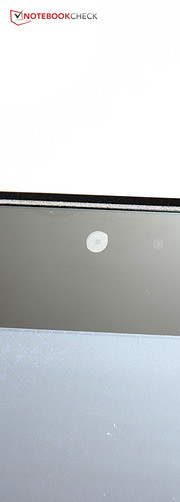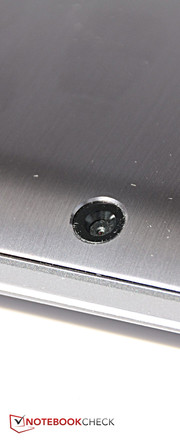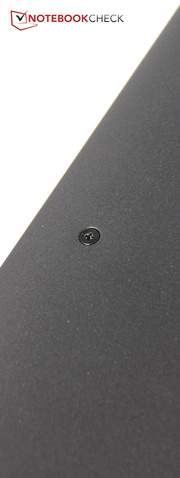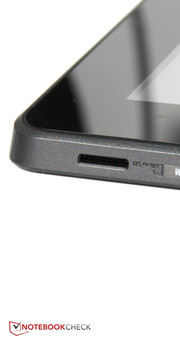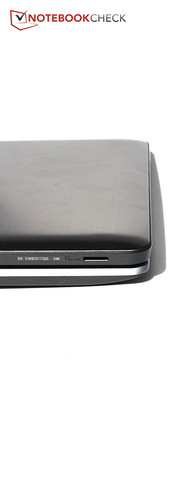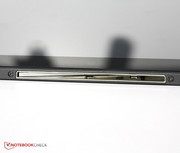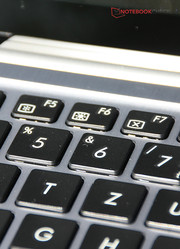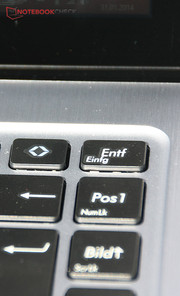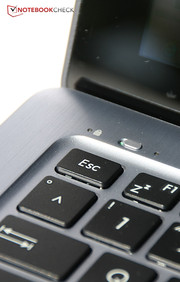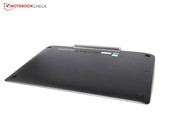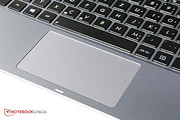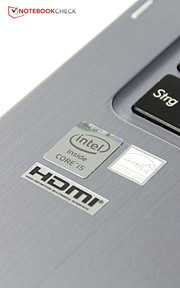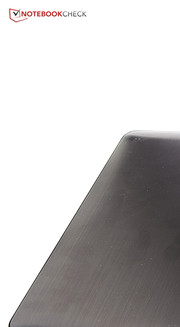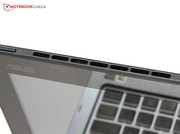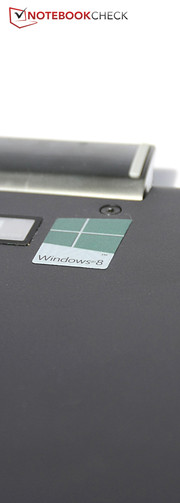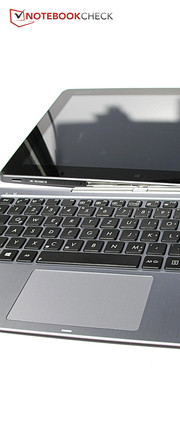Asus Transformer Book T300LA-C4006H Convertible Review

For the original German review, see here.
Looking back: About 11 months ago, we reviewed the Asus Transformer Book TX300CA and hoped a Haswell update was on the horizon. Squelched into the thin tablet case, the Ivy Bridge processor and its integrated graphics card throttled during our performance tests. The price of 1500 Euros (~$2028) was a little high too, to say the least.
Asus understood, and the company went back to their laboratory with their already chic, well-manufactured and wonderfully mutable convertible. We have the result before us: the Transformer Book T300LA-C4006H. The price has fallen by a good 600 Euros (~$811), which means a few features have disappeared: The USB charging port in the dock now only serves to charge the dock's battery to power the keyboard's Bluetooth, which means the dock's battery cannot charge the tablet. The extra hard drive in the keyboard dock was also dropped, and the only connection in the keyboard dock is now a single USB port. Also, the predecessor's nice magnetic charging plug was replaced by a "normal" plug.
With its slimmed-down list of features, the Transformer Book T300LA has to compete with rivals like the Surface Pro 2, which can also transform into a convertible with the Surface Pro Type Cover. The Toshiba Satellite W30t, the Lenovo Yoga 2 Pro and the HP Spectre 13 also step up to the plate as competitors.
Case
As was true of the T300LA's predecessor, the device's case is made of metal, and its manufacturing quality is very good. The two devices look quite distinct from each other: While the Transformer Book TX300CA had an abundance of ventilation slits in its lid, the top of our current test device is wholly intact. The ventilation slits have migrated to the sides of the convertible PC.
The tablet lid and keyboard cover are constructed out of a brushed metal that leaves no trace of fingerprints. The case's stability is good, though the keyboard dock does bend under strong pressure, and the tablet's display image distorts when a high degree of force is applied to the lid. The keyboard also produces a distinct clacking sound when twisted. Even so, the dock is certainly stable enough for typing. Uncomfortable: When we ran our hand over the metallic back side of the device in the vicinity of the processor, we felt a mild electric charge.
Connected to the dock, the tablet cannot tilt back very far -- likely to prevent the Transformer Book from falling backwards. Because almost all the hardware components are located in the tablet, the tablet is much heavier than the keyboard dock and can readily pull the whole device flat on its back. The relatively small maximum opening angle of 115 degrees could prove to be somewhat prohibitive.
A special connector plug forms the connection between the dock and the tablet. This connector does not transfer data; it merely serves as a physical connection. This connection is further strengthened by a magnet. The magnet almost does its job too well: If you set some part a bit askew, the magnet still pulls the tablet onto the dock, and a certain amount of strength is required to pull the two units apart and lock the tablet properly into place. Surprisingly, almost nothing has changed in terms of the keyboard dock's weight and measurements, even though Asus removed many hardware components from the dock.
Connectivity
As previously mentioned: Asus had to make cutbacks in terms of the Transformer Book's connections as well. A standard SD-card reader, a second USB port, a LAN connection, and a DisplayPort: The list of omitted connections is long. Besides a micro-USB port, which serves exclusively to charge the dock, the keyboard dock is completely devoid of connections. This micro-USB port is necessary to charge the keyboard and the touchpad because these input devices communicate with the tablet over Bluetooth, which means they can be used even when the tablet is not physically connected to the dock. Disadvantage: If the dock's battery is empty, the keyboard can only be used if you connect the tablet to the dock over USB. That means the only USB port on the tablet is occupied. Incidentally, if you own a dock from the previous Transformer Book and hope to use it with the new device, unfortunately, we must be the bearers of disappointing news: The new "docking port" is exclusively designed to connect the tablet with the dock and is not capable of transferring data.
The connections are located on the sides of the tablet: A micro-HDMI port, a power plug, and a USB 3.0 port. Oddly, Asus built the micro-SD card reader into the bottom of the tablet. When the dock is connected, the whole convertible has to be turned around or tipped backwards to access the slot.
Communication
The WLAN module that sends and receives signals in our test device goes by the name Intel Dual Band Wireless-N 7260. The module can use both the 2.4 GHz and the 5 GHz bands and supports the standard 802.11 a/b/g/n. The tablet also contains a Bluetooth 4.0 module.
In this author's environment, the wireless reception was very good: Ten meters from the router and through three walls, we still had full bars and the data transfer rates were high. After adding an additional three meters of distance and another wall between the tablet and the router, only half of the bars remained, and data flowed a little more slowly. But we still did not encounter any problems streaming video or browsing the web.
Accessories
Asus' website does not list any special accessories for the Transformer Book T300LA. Besides the device itself, the packaging contains nothing more than the power supply and a micro-USB cable for charging the dock. The sleeve, polishing cloth and cable tie included with the predecessor model are nowhere to be found.
Maintenance
The tablet cannot be opened -- at least not with a screwdriver, as no screws are visible. Because all the relevant components are installed in the tablet, the Asus Transformer Book T300LA-C400GH's accessibility for maintenance is extremely limited.
The underside of the keyboard dock does house several Phillips-head screws that are quite easy to remove, but the underside still cannot be lifted off. As the keyboard dock's battery is the only component that could be replaced, it is not worth the risk of damage and the effort it would take to pry it open.
Warranty
A sticker on the backside of the keyboard dock tells us that Asus offers their device with a 24-month warranty. However, this warranty is only valid in the country of purchase. The battery is outfitted with a 12-month warranty. Normally, a buyer would have to send in the device in a warranty case, but Asus can simplify this process "at their own discretion" if the buyer allows the device to be picked up or brings it back to the store where it was originally purchased.
Input Devices
Keyboard
At first glance, the keyboard in the Transformer Book T300LA's dock appears very similar to that of its predecessor. If you look more closely, however, you will notice an extra row of keys (Home, Page Up, Page Down, End) as well as the increased size of the arrow keys. The trade-off is that the arrow keys are now spaced more closely together, and the whole keyboard takes up more of the dock's width. Unfortunately, the backlighting on the predecessor model's keyboard is no longer a feature on the T300LA.
The keyboard's quality, however, has not changed: The keys have quite a long travel length and offer a click point that is somewhat soft but still distinct. The keys are now only 3 millimeters apart, but using ten fingers you can still hit them with reliable accuracy. Overall, those who type a lot will be quite pleased with this keyboard dock.
Touchpad
The ClickPad's basic design has not changed: It is still dressed in a silvery gray, and the two integrated keys are only separated by a line on the pad surface. The surface is still very comfortable, and fingers glide across it beautifully.
When we reviewed the predecessor model, we criticized the ClickPad's keys for the high degree of force needed to reach the click point and the excessively short travel length. Here, Asus improved the situation somewhat: The travel length is still quite short, but the keys are now easier to click. All in all, however, the keys' feedback is still not clear enough: If it were not for the rather loud click sound, the keys' tactile feedback would not give the user enough information to know whether they successfully clicked or not.
Touchscreen
The Transformer Book T300LA's capacitive touchscreen is easy to operate, though its surface generates a little too much friction for fingers to glide with perfect agility. However, it reacts reliably to input over the entire surface of the screen, including the corners, and its recognition of multi-touch gestures is flawless.
The display keyboard boasts the same high quality as many Windows devices. For a tablet-size screen, the keyboard is outfitted with very large keys and can be displayed in a variety of layouts. Handwritten input is supported.
Display
13.3-inches, Full HD resolution, and a glossy surface: The Transformer Book T300LA's display specs are exactly the same as its predecessor's. But Asus did select a different panel for their new product, as is clear from the display's brightness value and other measurements.
The first noticeable difference is that our test device's brightness is slightly lower than it was on the already not very bright Transformer Book TC300CA: We measured an average of only 220.3 cd/m² this time around. Additionally, with the brightness being only 79% similar across the screen, the brightness distribution is rather uneven. Another weakness: The brightness, which is no better than average for its class to begin with, sinks substantially in battery mode (to 175.6 cd/m²).
| |||||||||||||||||||||||||
Brightness Distribution: 79 %
Center on Battery: 175.6 cd/m²
Contrast: 848:1 (Black: 0.27 cd/m²)
ΔE ColorChecker Calman: 4.5 | ∀{0.5-29.43 Ø4.79}
ΔE Greyscale Calman: 5.52 | ∀{0.09-98 Ø5}
62.59% AdobeRGB 1998 (Argyll 1.6.3 3D)
70.3% AdobeRGB 1998 (Argyll 3D)
96% sRGB (Argyll 3D)
70.2% Display P3 (Argyll 3D)
Gamma: 2.42
CCT: 6227 K
Even so, the display's black value of 0.27 cd/m² is very low, so black areas do appear truly deep and dark. No grayness is visible to the naked eye here. The good black value helps the contrast too, which at 848:1 proves to be respectable.
Subjectively, the panel's color display seems a little pale. To look into this more closely, we observed it with a colorimeter and used the CalMAN software. The data tells us that the display's colors come quite close to the sRGB color space's reference values, meaning the impression the colors leave is very true to life. Additionally, the blue tones' saturation levels are greatly reduced to balance out the usual blue cast. Orange color tones deviate most strongly from the ideal value, but the overall average DeltaE deviation of 4.5 is relatively small. The grayscale values only diverge mildly from the ideal as well.
The AdobeRGB color space, which is important for professional image editing, is only half-covered. That means this device is not suitable for professional photo editors and the like.
The tablet's low brightness and highly reflective display surface make outdoor use difficult. Even if image content is visible, the strong reflections are not easy on the eyes, and it is necessary to switch sitting positions continually in order to see the display image. Because the panel's brightness is so weak, its usefulness in bright environments is very limited.
Performance
The jump we hoped Asus would make to the Haswell platform should not only improve the processor's energy efficiency, but also significantly increase the system's performance capabilities. The hardware components relevant for performance include an Intel Core i5-4200U processor with a base clock rate of 1.6 GHz and a TDP of 15 Watts supported by an Intel HD Graphics 4400 graphics chip with a clock speed of 1000 MHz. The system has 4096 MB of working memory at its command.
Processor
The Intel Core i5-4200U is a dual-core processor that can process up to four tasks simultaneously, thanks to Hyper-Threading. Its base clock rate is 1.6 GHz, though via turbo boost a single core can reach up to 2.6 GHz, or both cores can reach up to 2.3 GHz.
Microsoft's Surface Pro 2 runs on the same processor, and the two devices are more or less on par with each other in the Cinebench benchmarks. Compared to the predecessor model, the Transformer Book T300LA's speed has increased by a significant margin -- up to 33%. Subjectively as well, our convertible feels quick as it goes about its work; we did not notice any lags or long load times during our tests.
System Performance
With 4096 MB of working memory, the system is not exactly luxuriously supplied, but its resources are solid. A fast SSD forms another part of the team. In practice, we had no problems with everyday tasks like office applications, music players, video playback or streaming. Because of the quick SSD, the explorer also functions at lightning speed.
| PCMark 7 Score | 4357 points | |
| PCMark 8 Home Score Accelerated v2 | 1918 points | |
| PCMark 8 Creative Score Accelerated v2 | 2233 points | |
| PCMark 8 Work Score Accelerated v2 | 2348 points | |
Help | ||
| PCMark 7 - Score (sort by value) | |
| Asus Transformer Book T300LA-C4006H | |
| Asus Transformer Book TX300CA | |
| Microsoft Surface Pro 2 | |
| Toshiba Satellite W30t-A-101 | |
| Lenovo Yoga 2 Pro | |
| HP Spectre 13-h205eg x2 | |
| PCMark 8 | |
| Home Score Accelerated v2 (sort by value) | |
| Asus Transformer Book T300LA-C4006H | |
| Toshiba Satellite W30t-A-101 | |
| Creative Score Accelerated v2 (sort by value) | |
| Asus Transformer Book T300LA-C4006H | |
| Toshiba Satellite W30t-A-101 | |
| Work Score Accelerated v2 (sort by value) | |
| Asus Transformer Book T300LA-C4006H | |
| Toshiba Satellite W30t-A-101 | |
Storage Devices
Asus' mass storage device of choice is a SanDisk SSD with 128 GB of storage space. However, only about 80 GB remains available to the user, as the rest of the space is occupied by Windows, preinstalled software and the recovery partition.
Compared to its predecessor, the Transformer Book T300LA with its SSD has a substantial advantage when it comes to speed. In the realm of access times in particular, even our test device's competitors are outclassed. Overall, the Transformer Book's performance is almost exactly on par with that of the Lenovo Yoga 2 Pro's. Both of these devices gain appeal with their good transfer rates and quick data access times.
* ... smaller is better
Graphics Card
The Intel HD Graphics 4400 offers a base clock rate of 1000 MHz and even supports current graphics standards like DirectX 11.1 or OpenGL 4.0. Here we see a considerable increase in graphics performance compared to the TX300CA: Altogether, the Transformer Book T300LA is between 26% and 33% faster than its predecessor in this discipline.
However, compared to other models with the same GPU (Surface Pro 2) or even a slower unit (Toshiba Satellite W30t), our test device's graphics card is somewhat slower.
In essence, though, our GPU's relative slowness is insignificant at this level of performance, as none of these graphics cards can handle demanding 3D applications. However, the graphics power is sufficient for any everyday task you might throw at it.
| 3DMark 11 Performance | 703 points | |
| 3DMark Ice Storm Standard Score | 26490 points | |
| 3DMark Cloud Gate Standard Score | 3499 points | |
| 3DMark Fire Strike Score | 439 points | |
Help | ||
Gaming Performance
The Transformer Book T300LA is not designed for gamers, though it can, of course, be used for browser games or casual games, as long as the game's graphics are not too demanding. Core gamers will have to look elsewhere, of course, though the convertible can be used to play Diablo 3 in medium details at reduced resolution. More current and demanding games like Thief or Watch Dogs are unplayable.
| low | med. | high | ultra | |
|---|---|---|---|---|
| Diablo III (2012) | 45.3 | 30.2 | 25.6 | 13.6 |
| Thief (2014) | 14.2 | 8.3 | 7 | 4.3 |
| Watch Dogs (2014) | 12.2 | 9.2 | 1.5 |
Emissions
System Noise
The Intel processor's substantially improved energy efficiency is noticeable when it comes to the system's noise emission too: In idle mode, the Asus Transformer Book T300LA is either inaudible or barely audible at most -- we measured a maximum of 29.3 dB(A) here. Under load, the convertible proves to be considerably quieter than its predecessor -- our test device does not even quite produce 33 dB(A), whereas the TX300CA reached a sound pressure level of up to 39.9 dB(A).
The HP Spectre 13 is even quieter, thanks to its passive cooling. The Surface Pro 2 is on a similar plane with our test device, while the Toshiba Satellite W30t and Lenovo Yoga 2 Pro are much more audible. All in all, if noise bothers you, rest assured that there is nothing to worry about here.
Noise level
| Idle |
| 28.2 / 28.2 / 29.3 dB(A) |
| Load |
| 32.7 / 32.7 dB(A) |
 | ||
30 dB silent 40 dB(A) audible 50 dB(A) loud |
||
min: | ||
Temperature
With its keyboard dock, the Transformer Book T300LA has a big advantage over ordinary notebooks: The hardware components relevant for performance are located in the tablet, so the area around the keyboard does not grow warm. But even if you hold the tablet, you do not have to worry about your hands getting hot: A maximum of 40.6 °C (105.08 °F) under full load is certainly bearable. The predecessor reached up to 44 °C (111.2 °F), so here too the new Transformer Book T300LA does better. In idle mode, we measured up to 32.2 °C (89.86 °F) on the front side of the device -- at most a minimal increase in temperature.
The stress test shows that even under full load, the processor does not grow too warm, though both cores throttle to about 800 MHz. As a result, the temperature remains at an acceptable maximum of 76 °C (168.8 °F). However, because a full-load scenario will be extremely rare in practical use, especially both the CPU and GPU under full load simultaneously, our measurements during the PCMark 7 benchmark test are more realistic: When both cores are carrying two-thirds of their maximum load, their maximum turbo clock rate is still possible. Throttling only occurs in extreme conditions.
(+) The maximum temperature on the upper side is 39.9 °C / 104 F, compared to the average of 35.4 °C / 96 F, ranging from 19.6 to 60 °C for the class Convertible.
(±) The bottom heats up to a maximum of 40.6 °C / 105 F, compared to the average of 36.8 °C / 98 F
(+) In idle usage, the average temperature for the upper side is 28.4 °C / 83 F, compared to the device average of 30.3 °C / 87 F.
(+) The palmrests and touchpad are reaching skin temperature as a maximum (34.3 °C / 93.7 F) and are therefore not hot.
(-) The average temperature of the palmrest area of similar devices was 27.9 °C / 82.2 F (-6.4 °C / -11.5 F).
Speakers
It is a shame that Asus sacrificed the extra speakers in the Transformer Book TX300CA's keyboard dock in the name of economy; they were great. But in exchange, the company installed substantially higher quality speakers in the tablet. The "SonicMaster" technology Asus developed is designed to optimally configure the system's hardware and software to produce the best possible sound.
It actually works rather well: The maximum volume is remarkable, and the sound is well-balanced too. Mid-tones are perhaps a bit overemphasized while bass is a little lacking, but that is entirely to be expected on a tablet. With the "Smart Audio" software, the sound can be configured further: Alongside quick selection profiles like "music" or "film," there is also a detailed equalizer that uses symbols to explain the individual frequencies to newbies.
Energy Management
Power Consumption
Compared to its predecessor, our test device's energy consumption rates have changed substantially, as we expected. In every area, the Transformer Book T300LA's energy use is lower than the TX300CA's -- for instance, by more than 50% on average in idle mode (5.6 Watts; TX300CA: 11.8 Watts).
Overall, the Asus Transformer Book T300LA's energy consumption rates are very similar to those of the Microsoft Surface Pro 2, except for its maximum power usage rate under load: Here Microsoft's tablet uses up to 43.5 Watts, while the Transformer Book T300LA only consumes 28.1 Watts. Surely it is possible to use even less energy, but considering the Transformer Book T300LA's performance capabilities, its energy consumption rates are absolutely satisfactory.
| Off / Standby | |
| Idle | |
| Load |
|
Key:
min: | |
Battery Life
Obviously the Transformer Book T300LA has no need of a second battery in its dock to reach considerably better battery runtimes compared to its predecessor. The battery in the tablet has a capacity of 50 Watt hours, which is enough juice for 14 hours in idle mode. Surfing over WLAN, the tablet runs for about 11 hours before petering out.
Because our review device's battery is not one of the smaller ones (Surface Pro 2), nor does it run on an Ivy Bridge generation processor (Spectre 13), none of its competitors can offer as long a battery life. Congratulations to Asus for achieving such excellent battery runtimes.
Verdict
A considerably lower price -- and considerably less features. In reality, that is only fair, but the loss of a few things we grew fond of and learned to appreciate on the TX300CA still hurts.
The keyboard dock, for example, no longer feels like an important part of the Transformer Book -- now it is like any number of keyboard docks for tablets. The extra battery in the predecessor's dock was a great thing. It is true that our test device offers very good battery runtimes as it is, but with the extra battery the device could have run for substantially longer still. Also, considering the limited storage space offered by the SSD in the tablet, the hard drive in the keyboard dock was a welcome addition. The speakers in the dock offered extra sound, though in exchange the speakers in the tablet are now much better. It is also a weakness that the keyboard dock's weight has hardly decreased, despite its many missing features.
The strange tangle of cables that results from charging the keyboard dock's battery over USB can be straightened out a bit with a smartphone charging device, but we have to admit it is an odd construction.
Our nostalgia certainly starts to dissipate when we look at the device's performance and energy efficiency. Thanks to the new Haswell processor generation, there have been some big changes here: The Transformer Book T300LA offers considerably more than its predecessor. For gaming its performance is nowhere near sufficient, but for surfing the Internet or accomplishing ordinary office work it functions flawlessly.
All in all, the panel Asus chose produces a good picture. The input devices are absolutely satisfactory once again, and the device's temperatures and noise levels are very comfortable.
All told, the big tablet with a keyboard dock that Asus offers here is well-designed and can certainly keep up with its competitors. Disregarding the nostalgia we feel looking back at its predecessor, the new Transformer Book leaves a good impression with its high manufacturing quality, great operation, and flexibility as a tablet with a combined dock/Bluetooth keyboard.




